Advertisements
Chapters
![Lakhmir Singh solutions for Physics (Science) [English] Class 9 ICSE chapter 1 - Motion Lakhmir Singh solutions for Physics (Science) [English] Class 9 ICSE chapter 1 - Motion - Shaalaa.com](/images/physics-science-english-class-9-icse_6:911f810b387d4e338a7779e8e703c1e7.jpg)
Advertisements
Solutions for Chapter 1: Motion
Below listed, you can find solutions for Chapter 1 of CBSE Lakhmir Singh for Physics (Science) [English] Class 9 ICSE.
Lakhmir Singh solutions for Physics (Science) [English] Class 9 ICSE 1 Motion Very Short Answers 1 [Pages 19 - 22]
Is displacement a scalar quantity ?
State whether distance is a scalar or a vector quantity.
Change the speed of 6 m/s into km/h.
What name is given to the speed in a specified direction ?
Give two examples of bodies having non-uniform motion.
Name the physical quantity obtained by dividing ‘Distance travelled’ by ‘Time taken’ to travel that distance.
What do the following measure in a car ?
(a) Speedometer (b) Odometer
Name the physical quantity which gives us an idea of how slow or fast a body is moving.
Under what conditions can a body travel a certain distance and yet its resultant displacement be zero ?
In addition to speed, what else should we know to predict the position of a moving body ?
When is a body said to have uniform velocity ?
Under which condition is the magnitude of average velocity equal to average speed ?
Which of the two can be zero under certain conditions : average speed of a moving body or average velocity of a moving body ?
Give one example of a situation in which a body has a certain average speed but its average velocity is zero.
What is the acceleration of a body moving with uniform velocity ?
What is the other name of negative acceleration ?
Name the physical quantity whose SI unit is :
(a) m/s (b) m/s2
What type of motion is exhibited by a freely falling body ?
What is the SI unit of retardation ?
Fill in the following blank with suitable word :
Displacement is a…………………… quantity whereas distance is a………………………….
Fill in the following blank with suitable word:
The physical quantity which gives both, the speed and direction of motion of a body is called its……………
Fill in the following blank with suitable word :
A motorcycle has a steady……………. of 3 m/s2. This means that every………………. its…………….. increases by………….
Fill in the following blank with suitable word :
Velocity is the rate of change of……………………… It is measured in.............. .
Fill in the following blank with a suitable word:
Acceleration is the rate of change of ______ It is measured in ______
What type of motion, uniform or non-uniform, is exhibited by a freely falling body ? Give reason for your answer.
State whether speed is a scalar or a vector quantity. Give reason for your choice.
Bus X travels a distance of 360 km in 5 hours whereas bus Y travels a distance of 476 km in 7 hours. Which
bus travels faster ?
Arrange the following speed in increasing order (keeping the least speed first):
An athlete running with a speed of 10 m/s.
Arrange the following speed in increasing order (keeping the least speed first):
A bicycle moving with a speed of 200 m/min.
Arrange the following speed in increasing order (keeping the least speed first
A scooter moving with a speed of 30 km/h.
Write the formula for acceleration. Give the meaning of each symbol which occurs in it.
A train starting from Railway Station attains a speed of 21 m/s in one minute. Find its acceleration.
What term is used to denote the change of velocity with time ?
Give one word which means the same as ‘moving with a negative acceleration’.
The displacement of a moving object in a given interval of time is zero. Would the distance travelled by the object also be zero ? Give reason for your answer.
A snail covers a distance of 100 metres in 50 hours. Calculate the average speed of snail in km/h.


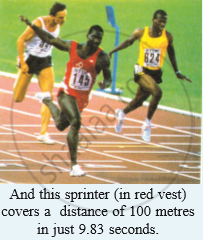
A tortoise moves a distance of 100 metres in 15 minutes. What is the average speed of tortoise in km/h ?
If a sprinter runs a distance of 100 metres in 9.83 seconds, calculate his average speed in km/h.
A motorcyclist drives from place A to B with a uniform speed of 30 km h-1 and returns from place B to A with a uniform speed of 20 km h-1. Find his average speed.
A motorcyclist starts from rest and reaches a speed of 6 m/s after travelling with uniform acceleration for 3 s. What is his acceleration ?
An aircraft travelling at 600 km/h accelerates steadily at 10 km/h per second. Taking the speed of sound as 1100 km/h at the aircraft’s altitude, how long will it take to reach the ‘sound barrier’ ?
If a bus travelling at 20 m/s is subjected to a steady deceleration of 5 m/s2, how long will it take to come to rest ?
What is the difference between distance travelled by a body and its displacement ? Explain with the
help of a diagram.
An ant travels a distance of 8 cm from P to Q and then moves a distance of 6 cm at right angles to PQ. Find its resultant displacement.
Define motion. What do you understand by the terms uniform motion and non-uniform motion ? Explain with examples.
Define speed. What is the SI unit of speed ?
What is meant by average speed?
What is meant by uniform speed ?
Define velocity. What is the SI unit of velocity ?
What is the Differnece between speed and velocity ?
Convert a speed of 54 km/h into m/s.
What is meant by the term acceleration ? State the SI unit of acceleration.
Define the term uniform acceleration. Give one example of a uniformly accelerated motion.
The distance between Delhi and Agra is 200 km. A train travels the first 100 km at a speed of 50 km/h. How fast must the train travel the next 100 km, so as to average 70 km/h for the whole journey ?
A train travels the first 15 km at a uniform speed of 30 km/h; the next 75 km at a uniform speed of 50 km/h; and the last 10 km at a uniform speed of 20 km/h. Calculate the average speed for the entire train journey.
A car is moving along a straight road at a steady speed. It travels 150 m in 5 seconds:
What is its average speed ?
A car is moving along a straight road at a steady speed. It travels 150 m in 5 seconds:
How far does it travel in 1 second ?
A car is moving along a straight road at a steady speed. It travels 150 m in 5 seconds:
How far does it travel in 6 seconds ?
A car is moving along a straight road at a steady speed. It travels 150 m in 5 seconds:
How long does it take to travel 240 m ?
A particle is moving in a circular path of radius r. The displacement after half a circle would be :
0
`pir`
2r
`2pir`
The numerical ratio of displacement to distance for a moving object is :
always less than 1
equal to 1 or more than 1
always more than 1
equal to 1 or less than 1
A boy is sitting on a merry-go-round which is moving with a constant speed of 10 m s−1. This means that the boy is :
at rest
moving with no acceleration
in accelerated motion
moving with uniform velocity
In which of the following cases of motion, the distance moved and the magnitude of displacement are equal?
if the car is moving on straight road
if the car is moving on circular road
if the pendulum is moving to and fro
if a planet is moving around the sun
The speed of a moving object is determined to be 0.06 m/s. This speed is equal to :
2.16 km/h
1.08 km/h
0.216 km/h
0.0216 km/h
A freely falling object travels 4.9 m in 1st second, 14.7 m in 2 nd second, 24.5 m in 3rd second, and so on. This data shows that the motion of a freely falling object is a case of :
uniform motion
uniform acceleration
no acceleration
uniform velocity
When a car runs on a circular track with a uniform speed, its velocity is said to be changing. This is because ______.
the car has a uniform acceleration
the direction of car varies continuously
the car travels unequal time intervals.
the car travels equal distances in unequal time intervals
Which of the following statement is correct regarding velocity and speed of a moving body?
velocity of a moving body is always higher than its speed
speed of a moving body is always higher than its velocity
speed of a moving body is its velocity in a given direction
velocity of a moving body is its speed in a given direction
Which of the following can sometimes be 'zero' for a moving body?
(i) average velocity
(ii) distance travelled
(iii) average speed
(iv) displacement
only (i)
(i) and (ii)
(i) and (iv)
only (iv)
When a car driver travelling at a speed of 10 m/s applies brakes and brings the car to rest in 20 s, then retardation will be :
+ 2 m/s2
− 2 m/s2
− 0.5 m/s2
+ 0.5 m/s2
Which of the following could not be a unit of speed?
km/h
s/m
m/s
mm s−1
One of the following is not a vector quantity. This one is :
displacement
speed
acceleration
velocity
Which of the following could not be a unit of acceleration?
km/s2
cm s−2
km/s
m/s2
A body is moving along a circular path of radius R. What will be the distance travelled and displacement of the body when it completes half a revolution ?
If on a round trip you travel 6 km and then arrive back home :
What distance have you travelled ?
If on a round trip you travel 6 km and then arrive back home :
What is your final displacement ?
A body travels a distance of 3 km towards East, then 4 km towards North and finally 9 km towards East.
What is the total distance travelled ?
A body travels a distance of 3 km towards East, then 4 km towards North and finally 9 km towards East.
What is the resultant displacement ?
A boy walks from his classroom to the bookshop along a straight corridor towards North. He covers a distance of 20 m in 25 seconds to reach the bookshop. After buying a book, he travels the same distance in the same time to reach back in the classroom. Find (a) average speed, and (b) average velocity, of the boy.
A car travels 100 km at a speed of 60 km/h and returns with a speed of 40 km/h. Calculate the average speed for the whole journey.
A ball hits a wall horizontally at 6.0 m s-1. It rebounds horizontally at 4.4 m s-1. The ball is in contact with the wall for 0.040 s. What is the acceleration of the ball ?
Lakhmir Singh solutions for Physics (Science) [English] Class 9 ICSE 1 Motion Very Short Answers 2 [Pages 39 - 44]
What remains constant in uniform circular motion ?
What changes continuously in uniform circular motion ? ‘
Earth moves around the sun with uniform velocity.
True
False
A body goes round the sun with constant speed in a circular orbit. Is the motion uniform or accelerated ?
What conclusion can you draw about the velocity of a body from the displacement-time graph shown below :
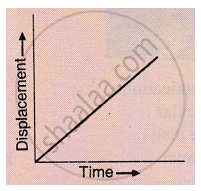
Name the quantity which is measured by the area occupied under the velocity-time graph.
What does the slope of a speed-time graph indicate ?
What does the slope of a distance-time graph indicate ?
Give one example of a motion where an object does not change its speed but its direction of motion changes continuously.
Name the type of motion in which a body has a constant speed but not constant velocity.
What can you say about the motion of a body if its speed-time graph is a straight line parallel to the time axis ?
What conclusion can you draw about the speed of a body from the following distance-time graph ?
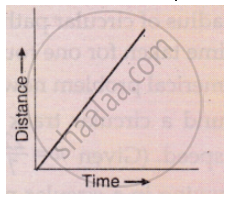
What can you say about the motion of a body whose distance-time graph is a straight line parallel to the time axis ?
What conclusion can you draw about the acceleration of a body from the speed-time graph shown below .
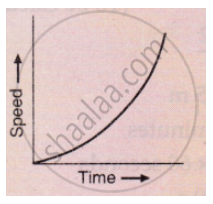
A satellite goes round the earth in a circular orbit with constant speed. Is the motion uniform or accelerated ?
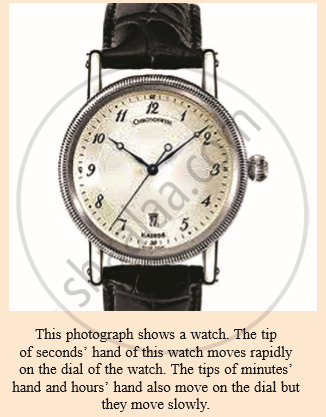
What type of motion is represented by the tip of the ‘seconds’ hand’ of a watch ? Is it uniform or accelerated ?
Fill in the following blank with suitable word :
If a body moves with uniform velocity, its acceleration is ..............
Fill in the following blank with suitable word :
The slope of a distance-time graph indicates ………………….. of a moving body.
Fill in the following blank with suitable word :
The slope of a speed-time graph of a moving body gives its………………………..
Fill in the following blank with suitable word :
In a speed-time graph, the area enclosed by the speed-time curve and the time axis gives the…………….. by the body.
Fill in the following blank with suitable word :
It is possible for something to accelerate but not change its speed if it moves in a………………………..
Is the uniform circular motion accelerated ? Give reasons for your answer
Write the formula to calculate the speed of a body moving along a circular path. Give the meaning of each symbol which occurs in it.
Explain why, the motion of a body which is moving with constant speed in a circular path is said to be accelerated.
What is the difference between uniform linear motion and uniform circular motion ? Explain with examples.
State an important characteristic of uniform circular motion. Name the force which brings about uniform circular motion.
Find the initial velocity of a car which is stopped in 10 seconds by applying brakes. The retardation due to brakes is 2.5 m/s2.
Describe the motion of a body which is accelerating at a constant rate of 10 m s–2. If the body starts from rest, how much distance will it cover in 2 s ?
A motorcycle moving with a speed of 5 m/s is subjected to an acceleration of 0.2 m/s2. Calculate the speed of the motorcycle after 10 seconds, and the distance travelled in this time.
A bus running at a speed of 18 km/h is stopped in 2.5 seconds by applying brakes. Calculate the retardation produced.
A train starting from rest moves with a uniform acceleration of 0.2 m/s2 for 5 minutes. Calculate the speed acquired and the distance travelled in this time.
Name the two quantities, the slope of whose graph give speed .
Name the two quantities, the slope of whose graph give acceleration.
A cheetah starts from, rest, and accelerates at 2 m/s2 for 10 seconds. Calculate :
(a) the final velocity
(b) the distance travelled.
A train travelling at 20 m s-1 accelerates at 0.5 m s-2 for 30 s. How far will it travel in this time ?
A cyclist is travelling at 15 m s-1. She applies brakes so that she does not collide with a wall 18 m away. What deceleration must she have ?
Draw a velocity-time graph to show the following motion :
A car accelerates uniformly from rest for 5 s ; then it travels at a steady’ velocity for 5 s.
The velocity-time graph for part of a train journey is a horizontal straight line. What does this tell you about the trains velocity.
The velocity-time graph for part of a train journey is a horizontal straight line. What does this tell you about its acceleration ?
Explain the meaning of the following equation of motion :v = u + at, where symbols have their usual meanings.
A body starting from rest travels with uniform acceleration. If it travels 100 m in 5 s, what is the value of acceleration ?
Derive the formula : v = u + at, where the symbols have usual meanings.
A bus was moving with a speed of 54 km/h. On applying brakes it stopped in 8 seconds. Calculate the acceleration.
Derive the formula s= `ut+1/2at^2` , where the symbols have usual meanings.
A train starting from stationary position and moving with uniform acceleration attains a speed of 36 km per hour in 10 minutes. Find its acceleration.
Write the three equation of uniformly accelerated motion. Give the meaning of symbol which occurs in them.
A car acquire a velocity of 72 km per hour in 10 second starting from rest. Find
(1) the acceleration,
(2) the average velocity, and
(3) the distance travelled in this time.
What is meant by uniform circular motion? Give two examples of uniform circular motion.
The tip of seconds’ hand of a dock takes 60 seconds to move once on the circular dial of the clock. If the radius of the dial of the clock be 10.5 cm, calculate the speed of the tip of the seconds’ hand of the clock. `("Given" π= 22/7)`.
Show by means of graphical method that: v = u + at, where the symbols have their usual meanings.
Show by using the graphical method that: `s=ut+1/2at^2` where the symbols have their usual meanings.
Derive the following equation of motion by the graphical method : v2 = u2 + 2as, where the symbols have their usual meanings.
A bus increases its speed from 36 km/h to 72 km/h in 10 seconds. Its acceleration is :
5 m/s2
2 m/s2
3.6 m/s2
1 m/s2
A bus moving along a straight line at 20 m/s undergoes an acceleration of 4 m/s2. After 2 seconds, its speed will be:
8 m/s
12 m/s
16 m/s
28 m/s
The slope of a speed-time graph gives:
distance travelled
velocity
acceleration
displacement
The area under a speed-time graph represents a physical quantity which has the unit of :
m
m2
m s−1
m s−2
If the displacement of an object is proportional to the square of time, then the object is moving with :
uniform velocity
uniform acceleration
increasing acceleration
decreasing acceleration
Four cars A, B, C and D are moving on a levelled, straight road. Their distance-time graphs are shown in the given figure. Which of the following is the correct statement regarding the motion of these cars?
car A is faster than car D
car B is the slowest
car D is faster than the car C
car C is the slowest
A car of mass 1000 kg is moving with a velocity of 10 m s−1. If the velocity-time graph for this car is a horizontal line parallel to the time axis, then the velocity of car at the end of 25 s will be :
25 m s−1
40 m s−1
10 m s−1
250 m s−1
A motorcycle is being driven at a speed of 20 m/s when brakes are applied to bring it to rest in five seconds. The deceleration produced in this case will be :
+ 4 m/s2
− 4 m/s2
+ 0.25 m/s2
−0.25 m/s2
A sprinter is running along the circumference of a big sports stadium with constant speed. Which of the following do you think is changing in this case?
magnitude of acceleration being produced
distance covered by the sprinter per second
direction in which the sprinter is running
centripetal force acting on the sprinter
In the speed-time graph for a moving object shown here, the part which indicates uniform deceleration of the object is :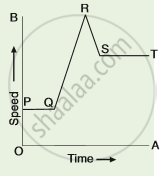
ST
QR
RS
PQ
A student draws a distance-time graph for a moving scooter and finds that a section of the graph is horizontal line parallel to the time axis. Which of the following conclusion is correct about this section of the graph?
the scooter has uniform by scooter is the maximum in this section
the distance travelled by scooter is the maximum in this section
the distance travelled by scooter is the minimum in this section
the distance travelled by the scooter is zero in this section
Which one of the following is most likely not a case of uniform circular motion?
motion of the earth around the sun
motion of a toy train on a circular track
motion of a racing car on a circular track
motion of hours' hand on the dial of a clock
The graph given alongside shows the positions of a body at different times. Calculate the speed of the body as it moves from :
(1) A to B,
(2) B to C, and
(3) C to D.

What can you say about the motion of a body if:
its displacement-time graph is a straight line ?
What can you say about the motion of a body if:
its velocity-time graph is a straight line ?
A body with an initial velocity x moves with a uniform acceleration y. Plot its velocity-time graph.
Given alongside is the velocity-time graph for a moving body :
Find :
(i) Velocity of the body at point C.
(ii) Acceleration acting on the body between A and B.
(iii) Acceleration acting on the body between B and C.

A body is moving uniformly in a straight line with a velocity of 5 m/s. Find graphically the distance covered by it in 5 seconds.
The speed-time graph of an ascending passenger lift is given alongside. What is the acceleration of the lift:
(1) during the first two seconds ?
(2) between second and tenth second ?
(3) during the last two seconds ?
A car is moving on a straight road with uniform acceleration. The speed of the car varies with time as follows :
Time (s) : 0 2 4 6 8 10
Speed (m/s) : 4 8 12 16 20 24
Draw the speed-time graph by choosing a convenient scale. From this graph :

(1) Calculate the acceleration of the car.
(2) Calculate the distance travelled by the car in 10 seconds.
The graph given alongside shows how the speed of a car changes with time:

(i) What is the initial speed of the car ?
(ii) What is the maximum speed attained by the car ?
(iii) Which part of the graph shows zero acceleration ?
(iv) Which part of the graph shows varying retardation ?
(v) Find the distance travelled in first 8 hours.
Three speed-time graphs are given below :

Which graph represents the case of:
(i) a cricket ball thrown vertically upwards and returning to the hands of the thrower ?
(ii) a trolley decelerating to a constant speed and then accelerating uniformly ?
Study the speed-time graph of a car given alongside and answer the following questions:

(i) What type of motion is represented by OA ?
(ii) What type of motion is represented by AB ?
(iii) What type of motion is represented by BC ?
(iv) What is the acceleration of car from O to A ?
(v)What is the acceleration of car from A to B ?
(vi) What is the retardation of car from B to C ?
What type of motion is represented by the following graph ?

What type of motion is represented by the following graph ?
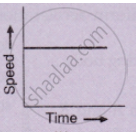
What type of motion is represented by the following graph ?
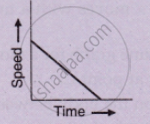
What type of motion is represented by the following graph ?

A car is travelling along the road at 8 ms-1. It accelerates at 1 ms-2 for a distance of 18 m. How fast is it then travelling ?
A car is travelling at 20 m/s along a road. A child runs out into the road 50 m ahead and the car driver steps on the brake pedal. What must the car’s deceleration be if the car is to stop just before it reaches the child ?
Solutions for 1: Motion
![Lakhmir Singh solutions for Physics (Science) [English] Class 9 ICSE chapter 1 - Motion Lakhmir Singh solutions for Physics (Science) [English] Class 9 ICSE chapter 1 - Motion - Shaalaa.com](/images/physics-science-english-class-9-icse_6:911f810b387d4e338a7779e8e703c1e7.jpg)
Lakhmir Singh solutions for Physics (Science) [English] Class 9 ICSE chapter 1 - Motion
Shaalaa.com has the CBSE Mathematics Physics (Science) [English] Class 9 ICSE CBSE solutions in a manner that help students grasp basic concepts better and faster. The detailed, step-by-step solutions will help you understand the concepts better and clarify any confusion. Lakhmir Singh solutions for Mathematics Physics (Science) [English] Class 9 ICSE CBSE 1 (Motion) include all questions with answers and detailed explanations. This will clear students' doubts about questions and improve their application skills while preparing for board exams.
Further, we at Shaalaa.com provide such solutions so students can prepare for written exams. Lakhmir Singh textbook solutions can be a core help for self-study and provide excellent self-help guidance for students.
Concepts covered in Physics (Science) [English] Class 9 ICSE chapter 1 Motion are Motion and Rest, Motion Along a Straight Line, Types of Motion, Measuring the Rate of Motion - Speed with Direction, Rate of Change of Velocity, Describing Motion, Distance and Displacement, Displacement - Time Graph Or Distance - Time Graph, Velocity - Time Graphs, Equations of Motion by Graphical Method, Derivation of Velocity - Time Relation by Graphical Method, Derivation of Displacement - Time Relation by Graphical Method, Derivation of Displacement - Velocity Relation by Graphical Method, Uniform Circular Motion (UCM), Motion (Numerical).
Using Lakhmir Singh Physics (Science) [English] Class 9 ICSE solutions Motion exercise by students is an easy way to prepare for the exams, as they involve solutions arranged chapter-wise and also page-wise. The questions involved in Lakhmir Singh Solutions are essential questions that can be asked in the final exam. Maximum CBSE Physics (Science) [English] Class 9 ICSE students prefer Lakhmir Singh Textbook Solutions to score more in exams.
Get the free view of Chapter 1, Motion Physics (Science) [English] Class 9 ICSE additional questions for Mathematics Physics (Science) [English] Class 9 ICSE CBSE, and you can use Shaalaa.com to keep it handy for your exam preparation.
